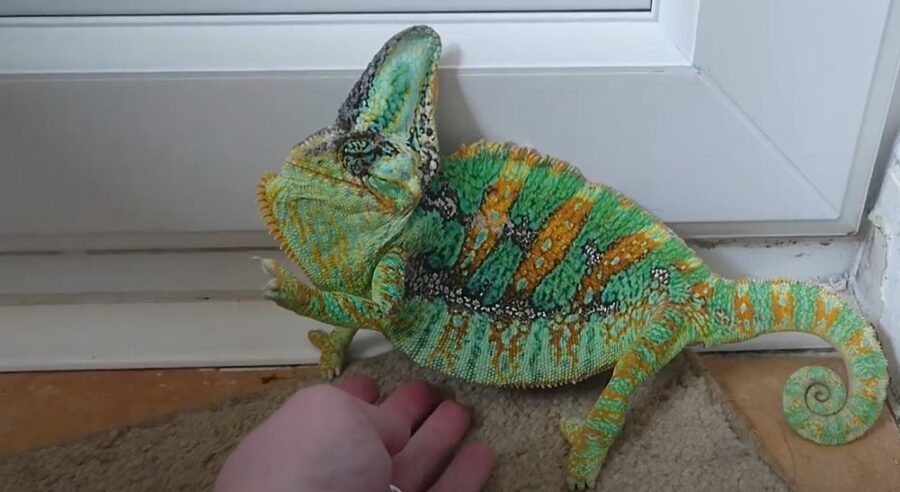Have you seen videos of chameleons fighting each other in the wild? Has your chameleon ever shown you an aggressive side?
What could make a chameleon aggressive or is this something in their nature that can’t be avoided?
You will learn a lot in this article about chameleon behavior, how they respond to threats and discover if, why and ultimately, “Are chameleons aggressive?”
Are Chameleons Aggressive?
Is your chameleon showing signs of aggression? A solitary reptile like a chameleon has adapted to life where they find their space within it and wish to not be disturbed.
Humans and many other animals have stronger instincts to show affection, but a chameleon may not reciprocate. They may puff themselves up, gape with their jaws open, hiss or bite when they feel threatened.
I would say a chameleon is more shy and reserved than aggressive. Chameleons do not carry venom or toxins and are not vicious creatures. They can defend themselves or blend in with their surroundings to avoid encounters and aggression.

Why Did My Chameleons Become Aggressive?
You brought home a docile, reserved any relatively shy reptile to your home. In time, things changed and you chameleon started showing signs of aggression. This happened to me too.
Chameleons only wish to be aggressive when they feel there is no other choice. Here are some reasons why:
- Warning off threats to back away
- Fast, sudden, jerky movements around them
- Enclosure too small
- High traffic areas
- Forced to interact with other chameleons or reptiles
- Rough or inexperienced handling
- Feeling cornered
- Stress
- Unnatural hand feeding
- Health issues
More information on these factors will continue to be uncovered and unpacked in this article. Stay with us to gain more clarity and solutions to calm aggressive chameleons.
7 Reasons Why Chameleons Get Aggressive
1. Body Language
Chameleons can warn you to back off with hissing sounds, puffing themselves up or when they open their mouths wide which is known as gaping. We might not know why this is happening, but we know that aggression can result if we continue to move closer to them.
2. Movements Around Them
Our movements are being monitored by our reptile companions. They want us to be gentler, slower, smooth and place their homes in areas that do not get too much traffic from adults, visitors, pets and children running around.
3. Enclosures
Small enclosures may make a chameleon feel cornered at times or stuck. They may need us to make adjustments to the way items are positioned.
Add elevated spaces and branch highways to give them more options to move around their space. Consider getting a larger cage for them if they have grown from their juvenile state.
4. Handle With Care
Chameleons may let people offer a hand, but they do not want us to initiate the action.
Instead of scooping up chameleons like other pocket pets such as rodents or rabbits, allow your chameleon to climb aboard if they feel like it. Rough handling or inexperienced handlers receive backlash or aggression sometimes from chameleons.
5. Hand Feeding
Feeding your chameleon by hand before establishing trust is a big no-no. You can still try it and help the bonding between you become closer and more caring with the offering of food by hand.
Choose the things a chameleon can eat with the purpose of giving them the best quality food. If your chameleon is hissing or not wishing to engage with you, leave the food on a leaf or somewhere in the enclosure for them to eat on their own.
6. Health Problems
Chameleons can feel vulnerable when they are sick. A weakened chameleon is a target for predators and even in their own species to push them out of their territory and be forced into hiding.
A chameleon may need to retreat and remain inactive when they are trying to recover or need medical attention. There are many signs from inspecting their poop, pale appearance, sunken eyes or more.
Approaching a sick chameleon who is retreating from you may result in aggression or their flight or flight response to bite you.
7. Housing Them Together
Chameleons don’t like to be kept together. They do not share well. They are territorial and aggressive when sharing spaces with either another male or female for long periods of time.

Chameleon Aggression Warning Signs
Is your chameleon trying to communicate with you and warn you before they get aggressive? See the warning signals and know when to back off.
- Eyes are glaring at you
- Skin turning black
- Brighter than usual colors
- Puffing up
- Gaping Mouth
- Hiss
- Lunge
1. Glaring Eyes
Eyes glare when a chameleon is fixed on you. They follow your movements and analyze whether or not you are a threat. Their eyes may also bulge out of their sockets when you get too close. You are being observed carefully and you might not be trusted.
2. Darker Color
Blackening or darker colors on chameleons signify their mood shifting to an angrier or suspicious state. When I get visitors over to my house, I want to show off my chameleon’s colors, but he turns black.
He wants to blend in with a darker area of the enclosure furthest away from us and he wishes to be left alone.

3. Brightening Up
Brighter colors usually happen when a chameleon is showing off or acting very confident. They may do this during their attempt to captivate a future mate or to defend territory.
Brighter colors are like tribal paint when it’s time to go to war. This occurs less often than turning black, but it usually means your chameleon is ready for a fight if one occurs. The common bright color is a shade of green.
4. Puffed Up
Puffing up their bodies makes chameleons look larger than they actually are. The throat flap goes over their jaw and they stand more erect and longer in appearance.
The bigger they can look, the more they can try to convince an intruder in their space to back away before things get more tense.
5. Gaping
Gaping Mouths are when chameleons open up wide to show off their diminutive teeth. They are not yawning, but getting ready to bite if necessary.
6. Hissing
Hissing can release a long drawn out push of air or a short burst. Sharp hissing sounds are high in tone and a very obvious signal to warn anyone or anything that they mean business. Never approach a hissing chameleon.
7. Lunging
If a chameleon lunges at you, you have failed to notice some of the signals above or disregarded them. The lunge is the final warning before any aggression coming from their claws (nails) or teeth. Prepare for contact or you can finally back away and leave this territorial chameleon alone for now.

Most Aggressive Chameleons
It is hard to pick out the most aggressive chameleons from an entire species of solitary creatures who do not usually instigate or initiate contact.
Veiled chameleons are popular in captivity and because of that, there are many instances of this species interacting in aggressive ways with human caregivers.
They usually want distance, space and no sudden movements around them. Panther chameleons are less aggressive, but are prone to hiss at on-comers who invade their space. I find that panther chameleons do not enjoy being handled.
When it comes to any species of chameleon, you can make the necessary improvements, take your time and provide comforts to build trust and alleviate tension for them to back down and enjoy their new life with you.
How To Make An Aggressive Chameleon More Comfortable
Your chameleon may warn you with aggression, but you can thwart that, improve conditions and return to a more comfortable state for both of you and everyone else involved. Here’s what you can do.
- House them in areas with less foot traffic.
- Give your chameleon more climbing spaces, branches and elevated walkways.
- Offer foliage, hiding spaces and moisture.
- Be patient for the settling in process to take its time before initiating contact.
- Resist handling unless they initiate it.
- Hand feed only if you don’t hear hissing or other warning signs to stay away.
- Feed with tongs or drop the food on a leaf for now.
- Do not force your chameleon to leave their enclosure if they don’t want it.
- When handling becomes trusted, bring them to a fun location like a planted area or sunny spots.
Final Thoughts
An aggressive chameleon may not stay that way. There’s always time and strategies to improve their state of mind and add comfort to their lives.
With each action, there’s a positive or negative or reaction from your chameleon. With experience, observation and trust from both pirates, the thick cloud that sparks aggression will part for sunny skies and warm interaction between the both of you.
Thank you for visiting PocketPetCentral.com for the best information to help you enjoy the life of your pocket pet companion in a fun, safe & healthy way.

